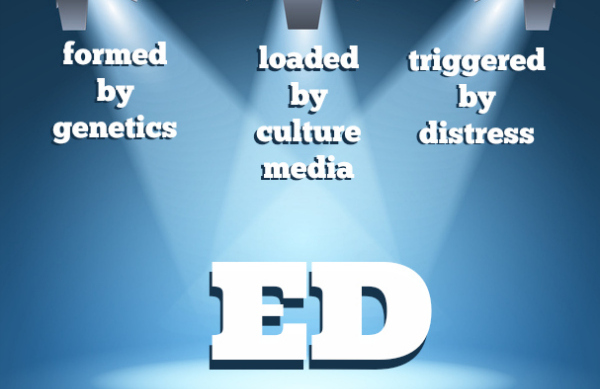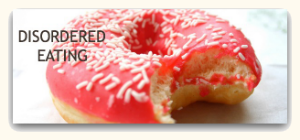Much has been written and argued about the real causes of eating disorders (ED), perhaps so because ED is such a complex arena. Psychologists and practitioners are constantly proposing new links and triggers to be studied and considered, and the Diagnostic and Statistical Manual on Mental Disorders (DSM) is now on its fifth round with over 290 different diagnoses.
To make matters easier for us, we will consider the following definition:
Eating Disorders are formed by genetics, loaded by culture, media and environment, and triggered by distress.
Let’s now examine each one of these components and see what they mean:

ED are formed by genetics
While the jury is still out there on how to connect the dots, studies do suggest that some individuals will have a genetic pre disposition towards ED.
There are many studies that indicate a correlation between mood disorders and ED, which means that individuals who suffer from anxiety and depression are more likely to be affected. Therefore, mood disorders such as depression and anxiety are starting to be understood as possible pathways into ED.
Another aspect that falls into this biology category is brain chemistry. Scientists are conducting studies that suggest that brain differences predispose people toward bulimia and anorexia. While it is not clear whether these differences are the result of nutritional trauma or if they are actually inherited (though studies suggest the latter), the differences between an ED brain and the brain of somebody who is unaffected are visible. For example, there is clear difference in the centers that control impulse behaviors, working memory, pleasure, and pain moderation.
MRIs have shown an increased activity of impulse controlling behaviors in anorexia (the person is able to control hunger pangs and appetite) whereas people with binge eating disorder tend to have less activity in this self-control area.
In terms of working memory we see high activity, related to counting calories and learning and memorizing fairly complicated eating rules.
There is also relatively low activity in pleasure centers (ability to enjoy) and high pain moderation (less ability to feel pain). (1)
ED is loaded by culture, media and family
The connection between cultural influence and ED is yet to be firmly established, however we cannot deny that our culture does have a high degree of disfunctionality when it comes to understanding and honoring body and weight diversity. Both media and industry add to this distortion, making matters worse.
As Dr Cynthia Bulik points out (2), on the one hand we receive a message of “change and control your body” from Big Diet, Big Cosmetic and Big Fashion, while on the other we are told to “indulge” by Big Food, Big Sugar and Big Beverage. These contradictory messages only generate more confusion around our body image and our self-perception.
The last element mentioned in this category is family. When it comes to family relationships, much has changed since the original days of ED treatment. Many years ago psychologists were keen to establish a connection between ED and dysfunctional families or unloving mothers. However this perspective has been revised, to the relief of thousands of loving parents whose children are affected by ED. While it is true that there will be dysfunctional families in which abuse and trauma will significantly add to an ED, in most cases we can say that family rules and parenting styles do not create an ED – but there might be certain dynamics in the family that fuel a predisposition (for example, if parents diet or suffer from ED themselves).
ED is triggered by distress
Now that we have understood the genetic and biological background plus the influence of environment, we need to emphasize that there is usually a trigger for ED – and it is not the same for everybody.
Especially in the case of teenagers, parents find it very hard to understand that what triggers their children into an episode of ED is something that is not an issue for them. But everybody is different, and a situation that you perceive as unproblematic might be lived in a whole different light by an anxious or depressed child (or that said, by a child who is engaging in dieting behaviors).
This is why learning to cope with stressors and triggers is such a pivotal part of the recovery process.
I hope that the description of these three main areas of influence for ED will give you a better understanding on what eating disorders are about, letting go of stigma and hopefully answering some of the questions you might have around this sensitive topic.
(1) see The Neuroscience of Unbalanced Eating, Scientific American Mind, March/April 2014, and The Anorexic Brain, Science News, August 2010.
(2) Cynthia Bulik, Midlife Wating Disorders, 2013.









